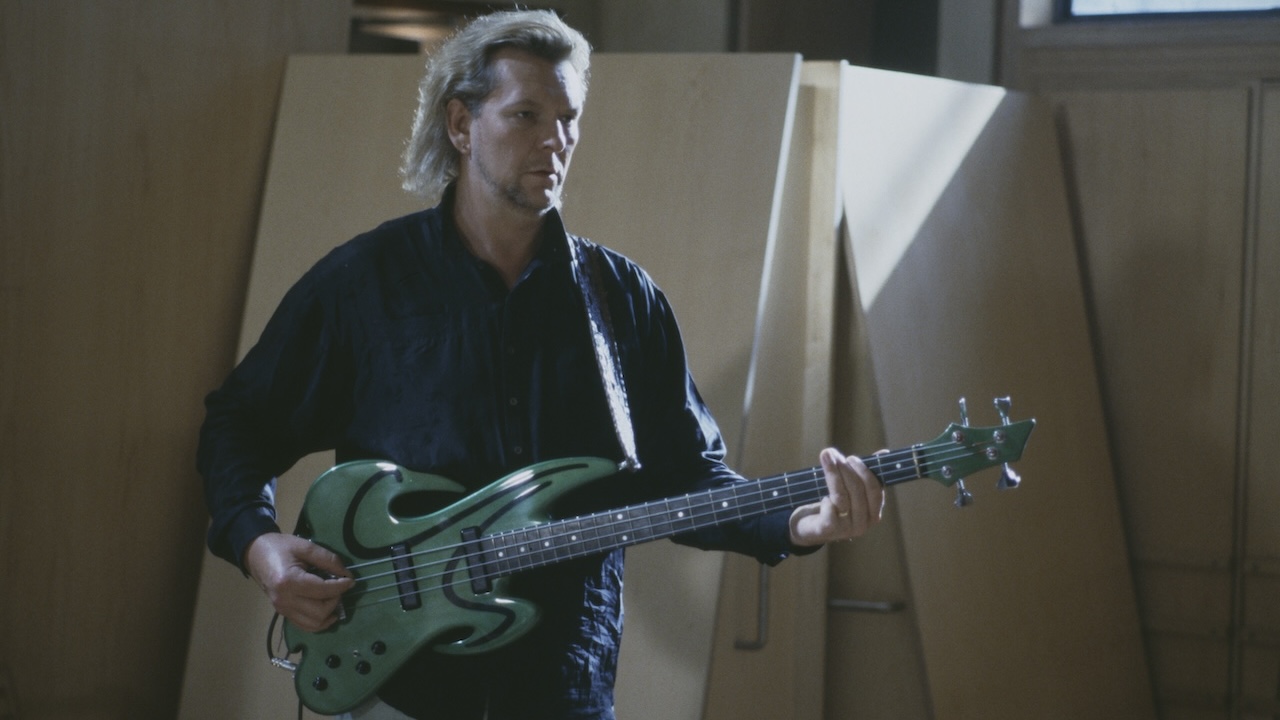“When I first visited the Rickenbacker factory, I thought I was going to get a hero's welcome. But they were like, ‘Come take a look at our repair room’”: Why Chris Squire’s relationship with Rickenbacker got off to a rocky start
Chris Squire's Rickenbacker underwent several changes over the years, the most radical coming when he rewired the single-output bass with stereo outputs

The classic Chris Squire bass tone is best described as clanky, clacky, brittle, hollow and so on, but rather than deciphering endless adjectives it's probably best to listen to Roundabout and marvel at its prominent, treble-loaded tone, delivered with startling picking speed and agility.
Squire referred to the bassline as “quintessential” with some humour, having been asked about it so many times, but he was right – it perfectly sums up his approach to the bass guitar.
Squire, who died in 2015 from leukaemia, was best known for playing a 1964 Rickenbacker with the serial number DC127, often thought to be a regular 4001S model. It was actually an RM1999 – in other words, an import into the UK by Rose Morris, Rickenbacker's official British importer at the time.
Asked why he chose a Ricky, Squire explained: “Because when they originally came into England, Pete Quaife from the Kinks bought one, and John Entwistle bought one. I worked at a guitar shop called Boosey & Hawkes, who were the importers, and I got the third one.
“It's a brilliant bass... I have a relationship with it; it just plays itself, really. The pickups are all cockeyed and crappy; by modern standards they wouldn't figure as being efficient at all. But it's the inefficiency that makes it so good.”
Squire's Rickenbacker underwent several drastic changes over the years, the most radical coming when he rewired the single-output bass with stereo outputs in the early '70s.
His idea was that certain effects worked better with either the neck or bridge pickup, a concept copied by a few notable bassists over the years.
All the latest guitar news, interviews, lessons, reviews, deals and more, direct to your inbox!
“I invented that whole thing! I didn't do it because I wanted to play in stereo. It’s because I loved the fuzz tone I could get from the neck pickup, but with the bridge pickup, the fuzz was horribly nasal-sounding. All of my guitars have stereo outputs for that reason. With new innovations through the years, these little nuances have come into play and been part of my development.”
Squire covered the bass in flowery wallpaper in the hippie era, but when he wanted to move on from that look, removing the paper also entailed the removal of the original Fireglo finish. He then covered it with silver paper, and once again, this needed to be sanded off when he grew tired of it. His tech applied a cream lacquer finish to the bass, which now weighed a bit less than a regular Rickenbacker: This was also a factor in its sound, said Squire, although it's unknown if this was ever professionally assessed.
His signature 4001CS bass, when it was launched in 1991, didn't sound exactly like the original, though, so maybe he was onto something.

More modifications were made in the mid-'80s by luthier Michael Tobias, who told Bass Player, “The peghead had been broken off more than once. When I got the bass, it was hanging by a thread, and there was almost no glue surface left. The break was almost straight through under the nut.
“Because of the way Rickenbacker cut out the truss-rod access, there wasn't much area to rebond. I got a new rod system and made a scarf joint so there'd be some area to glue. I recreated the original peghead with the proper wood, attached it, shaped it to the existing neck profile, and matched the paint.”
It emerged that the RM1999's bridge pickup, which Squire referred to as having a “tinny sound”, was defunct by the time Tobias got to it. “It was actually dead. I installed a new pickup from Rickenbacker, but Chris didn't like it, so I put the old pickup back in. It would pick up a little from the working pickup and make some sound, but not on its own.”
Squire used a dozen or so basses across his career, including four-strings from Lakland, Tobias, MPC and Yamaha, a Ranney eight-string and Fender Telecaster and Jazz basses. As well as the original Rickenbacker, the two basses that received the most attention were a Wal triple-neck given to him by Rick Wakeman – and first played by Wakeman bassist Roger Newell – and a green Jim Mouradian bass.

The former featured doubled A, D, and G strings at the top, a fretted four-string in the center and a fretless four-string on the bottom – and, along with Geddy Lee's twin-neck Rickenbacker, is probably the ultimate prog-rock instrument.
Of the Mouradian, he explained in a webchat: “Jim Mouradian and myself designed the bass. The way the wood is shaped is in the initials C and S. It looks like a fairly '80s metal design in a way.”
This being Chris Squire, more tales abound of some genuinely innovative approaches to bass – such as a bass fitted with guitar strings, on which he played four-string chords, and a Gibson double-neck that he played on the song Safe on the Fish Out Of Water album.
The innovation here was that he played the bass with only the guitar neck's pickups switched on, leading to a ringing, resonant tone that didn't sound remotely like a regular bass.
In all cases, Squire always used a standard-gauge set of Rotosound Swing Bass roundwound strings, attributing some of his tone to this choice. “The first person I knew to use them was John Entwistle. As far as I remember, he was very responsible for developing them with James Howe, who originally started the company.
“John said to James Howe that he wanted the bass to sound more like the low-end of a grand piano, and that was that. I'm a dyed-in-the-wool Who fan since I was a teen, and I always loved John's sound, so I tried the strings, too.”
“The story goes that the guys at Rickenbacker got rather upset at me. Because people were putting Rotosound roundwounds on their Rickenbackers, they were wearing down the softer fretwire on those earlier basses.
“When I first visited the Rickenbacker factory, I thought I was going to get a hero's welcome. But they were like, ‘Come take a look at our repair room,’ where they had a hundred basses that had been returned. We have a good relationship now, but originally we had a rocky start!”

Nick Wells was the Editor of Bass Guitar magazine from 2009 to 2011, before making strides into the world of Artist Relations with Sheldon Dingwall and Dingwall Guitars. He's also the producer of bass-centric documentaries, Walking the Changes and Beneath the Bassline, as well as Production Manager and Artist Liaison for ScottsBassLessons. In his free time, you'll find him jumping around his bedroom to Kool & The Gang while hammering the life out of his P-Bass.


